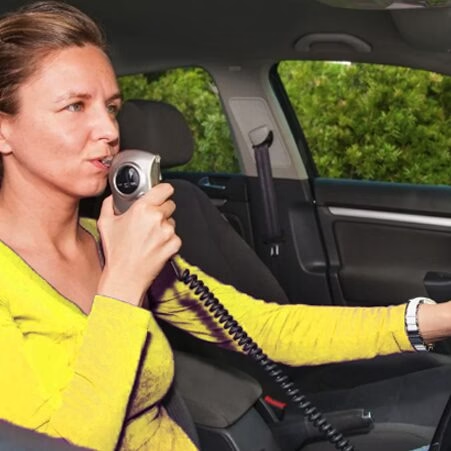Vehicle Interlock and Monitoring Devices for Florida DUI Offenders
If you’ve been convicted of a DUI in Florida, there’s a good chance you’ll be required to install a vehicle ignition interlock device (IID). These devices are not just penalties—they’re safety tools intended to help drivers regain legal driving privileges while reducing the risk of repeat offenses. This guide will walk you through what interlock devices are, when they’re required, how they work, and what you can expect in terms of installation, monitoring, and cost.
What Is an Ignition Interlock Device?
 An ignition interlock device is a small, handheld breathalyzer that's installed in your vehicle. Before you can start the engine, you must blow into the device. If your breath alcohol content (BrAC) is above the programmed limit—typically 0.025 or lower—the engine won’t start.
An ignition interlock device is a small, handheld breathalyzer that's installed in your vehicle. Before you can start the engine, you must blow into the device. If your breath alcohol content (BrAC) is above the programmed limit—typically 0.025 or lower—the engine won’t start.
Most devices also require periodic “rolling retests” while you drive. This ensures continued sobriety throughout your trip and prevents someone else from blowing into the device on your behalf.
When Is an Interlock Device Required in Florida?
The State of Florida mandates interlock installation for many DUI offenders, depending on factors such as:
- Whether this is your first or a repeat DUI offense
- Your blood alcohol level at the time of arrest
- Whether minors were present in the vehicle
- If there were injuries or property damage
Florida Interlock Requirements by Offense
- First DUI offense: Interlock may be required for 6 months if BAC was 0.15 or higher or if a minor was in the vehicle.
- Second DUI offense: Required for a minimum of 1 year.
- Third DUI offense: Required for at least 2 years.
- Fourth or subsequent offenses: Minimum 5 years.
The Florida Department of Highway Safety and Motor Vehicles (FLHSMV) will notify you of your requirement and eligibility during the reinstatement process. In many cases, proof of installation is necessary to receive a restricted or hardship license.
How Does the Interlock Device Work?
- Startup test: Before you can start the car, you blow into the mouthpiece. If you pass, the engine will start. If not, the vehicle stays disabled for a set period (usually a few minutes to several hours).
- Rolling retests: You’ll be asked to provide additional breath samples while driving. Failing to provide a sample or failing the test can trigger an alert and may be recorded as a violation.
- Data logging: The device records test results, failed attempts, missed retests, and other tampering or circumvention attempts. This data is reviewed by your monitoring agency.
Who Installs the Interlock Device?
Only state-approved vendors are authorized to install ignition interlock devices in Florida. The FLHSMV maintains a list of approved providers, including companies like:
- Intoxalock
- Smart Start
- LifeSafer
- Alcolock
These vendors have locations throughout Florida and typically offer installation appointments within a few days of contact. Installation takes about 1–2 hours and includes instructions on how to use the device properly.
What Does It Cost?
The total cost of using an ignition interlock device includes installation, monthly monitoring, and removal. Here’s a breakdown of typical costs:
- Installation: $70–$150
- Monthly rental & monitoring: $70–$100
- Device removal: $50–$100
Some providers offer financial assistance if you qualify based on income or government aid. You may be required to provide tax returns or pay stubs to demonstrate eligibility.
Additional Monitoring Devices
In addition to interlock devices, Florida DUI offenders may be required to participate in other monitoring programs:
- SCRAM Devices: These are ankle monitors that track alcohol consumption 24/7 through skin perspiration.
- Random drug and alcohol testing: Some drivers on probation may be required to submit to random urinalysis or breathalyzer tests.
- Camera-enabled IIDs: Some interlock devices include cameras to verify the identity of the person providing the breath sample.
Violations and Penalties
Trying to bypass or tamper with an interlock device is a serious offense. Potential consequences include:
- Extended duration of the interlock requirement
- Revocation of your restricted license
- Additional criminal charges or fines
Common violations include:
- Failing a breath test
- Missing a rolling retest
- Allowing someone else to blow into the device
- Missing calibration appointments
Hardship Licenses and FR‑44 Insurance
In most cases, installing an interlock device is a required step in getting a hardship license after a DUI suspension. You’ll also need to submit proof of FR‑44 insurance—an elevated liability coverage required for high-risk drivers in Florida.
FR‑44 insurance typically includes:
- $100,000 bodily injury coverage per person
- $300,000 per accident
- $50,000 in property damage coverage
We work with multiple FR‑44 providers in Florida and can help you find affordable coverage that meets all state requirements.
How to Get Started
If you've been ordered to install an ignition interlock device, follow these steps:
- Contact an approved provider to schedule installation.
- Notify FLHSMV once installation is complete.
- Maintain regular calibration appointments (typically every 30 days).
- Comply with all monitoring rules to avoid violations.
Need Help?
At MyFloridaFR44.com, we understand how overwhelming it can feel to navigate DUI penalties. Our goal is to help you fulfill state requirements—like installing an IID and securing FR‑44 insurance—so you can get back on the road legally and safely.
Have questions? Contact us today and we’ll walk you through the steps, answer your questions, and connect you with the right partners to move forward.

